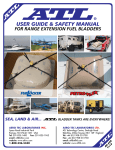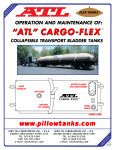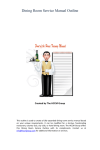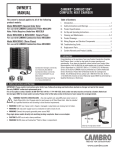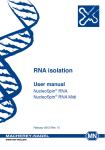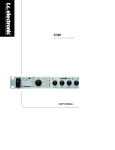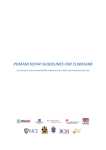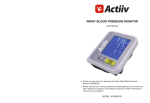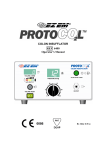Download USER GUIDE & SAFETY MANUAL
Transcript
® USER GUIDE & SAFETY MANUAL FOR RANGE EXTENSION FUEL BLADDERS ® SEA, LAND & AIR... AERO TEC LABORATORIES INC. Spear Road Industrial Park Ramsey, NJ 07446-1251 USA Tel: 201-825-1400 Fax: 201-825-1962 email: [email protected] website: www.atlinc.com 1-800-526-5330 BLADDER TANKS ARE EVERYWHERE! AERO TEC LABORATORIES LTD. ATL Technology Centre, Denbigh Road Bletchley, Milton Keynes MK1 1DF England Tel: +44 (0) 1908-351700 Fax: +44 (0) 1908-351750 email: [email protected] website: www.atlltd.com ® 8 4 5 S- 3 D x1 8 ATL PETRO-FLEX® RANGE EXTENSION BLADDERS (REB) ATL FUELOCKER™ RANGE EXTENSION BLADDERS (REB) I.) ATL “REB” Applications ATL REBs Are Intended For: a) Ferrying unpressurized aircraft under permit and sanction of the F.A.A. or other jurisdictional body b) Carrying reserve fuel on the open deck of U.S.C.G. - compliant boats including commercial, defense and pleasure craft c) Extending the travel range of: off-road vehicles, construction equipment, open trucks and military equipment d) Providing a fuel supply for power generators, water pumps, air compressors, HVAC components, cement mixers and the like II.) ATL “REB” Compatibility ATL REBs Should Be Used To Hold Hydrocarbon Fuels Only: a) Gasoline; to 30% aromatics (ASTM Fuel B) b) Diesel and Bio-Diesel Fuel c) Turbine Fuels; JP4, 5, 8, 10, JetA, B, etc. d) Heating Oils; #2, #4 e) Collected vapors and condensates of fossil fuels ATL FueLocker™ f) Kerosene, mineral spirits and isooctane g) Gasoline/alcohol hybrids up to 15% (homogenious) methanol or ethanol, (M15, E15) h) Vegetable oil type bio-fuels and combustible plant extracts i) Bio-Butanol j) High-octane leaded race fuels ATL Petro-Flex® 1 III.) ATL “REB” Dynamic Restraint ATL REBs Used In Mobile Applications Must Be Secured Or Restrained By One Of The Following Methods: a) Within a ventilated rigid container, compartment, locker or nacelle b) Under a fastened cargo net or nylon web harness c) Within (4) ratchet tie-down straps; one in each direction (per cover photos) d) Or another active restraint able to absorb 3 g. loadings along all axis In rough weather and during hard maneuvers, ATL REBs might shift or roll without an adequate tie-down system. Do not take chances, secure the fuel load for all contingencies. Diagram Refers to BOTH Petro-Flex® and FueLocker™ ATL Tie-Down Collar with ratchet straps at 4 equally spaced points. Bladders can also be secured with cargo nets and harness webs. If a partial discharge of fuel (not recommended) is made, re-tighten the straps or cargo net to restrain the bladder. 2 IV.) ATL Range Extension Bladders “REB” General Safety 1) ATL REBs generally contain flammable or combustible liquids and all relevant fire safety precautions apply. These bladder tanks can store leaded gasoline, diesel fuel, E-10 unleaded gasoline, 100-LL aviation fuel and JP8 (kerosene) jet fuel. Before using, dedicate your REB to ONE SPECIFIC FUEL and mark the bladder accordingly near the fill neck with a Sharpie, Flair or other indelible pen. Never mix dissimilar fuels! 2) Keep the fuel bladder tightly restrained to prevent shifting and rolling. On abrasive surfaces, protect the ATL REB with a rubberized “Underliner”. 3) Keep flame, heat, spark and static charges away from all ATL REB tanks. A static ground strap from the outlet fitting to neutral earth is recommended. 4) Before filling any bladder tank, check the entire installation for cuts, abrasions, leaks or other potential hazards. 5) Transfer fuel only when the vehicle is at rest or in a thoroughly stable mode. Wear protective clothing as described in attached Bulletin #DS-370. 6) It is recommended to carry ATL REBs either full or empty. Partial loads are more prone to surge, roll and shift and therefore require regular adjustment to the restraint straps. 7) Transfer fuel by pump or siphon only in a well ventilated area with non-sparking, explosion-proof equipment. 8) Do not overfill the bladder tank, and be certain all seals and valves are leak tight. 9) Always fill the bladder tank slowly; remove and replace the cap carefully; open the discharge valve gradually and tighten the tie-down straps uniformly. Abrupt and careless handling can cause fuel spillage and a potential fire hazard. Keep a Class BC (Purple K) fire extinguisher handy in case of ignition. 10) To protect the ATL REB’s bottom surface, always position the bladder on a clean, smooth surface or use an ATL “Underliner” or “Ground Cloth” for chafe avoidance. 11) When storing an ATL REB, drain all fuel; collapse the bladder flat to expel vapors; wrap padding around all fittings; fold up the bladder and wrap it in a polyethylene bag. If storing above deck, ATL’s mesh tote-bag is a great option that makes for easy transport as well. 12) For maximum bladder life, minimize the tank’s exposure to intense sunlight, extreme heat and cold, pressurization, fungus, abrasion and high humidity. Avoid repeated folding along the same crease lines, as this practice may cause unnecessary wear. 13) Since fuel vapors are frequently flammable, ATL REBs are to be used only in open, well-ventilated spaces. Immediately clean up any fuel spills, and preferably discharge fuel directly to the vehicle’s main tanks. Use top quality hoses, pumps, valves and fittings when installing an ATL REB auxiliary fuel tank. Keep the ATL REB exterior clean and dry. 14) The fill and outlet fittings (bosses) on ATL REBs are of composite plastic construction so as to be corrosion resistant, non-sparking and impact resistant. However, these threaded bosses are not intended to be connected to metallic pipe. Do not alter the fitting arrangements on ATL REBs, and if a replacement part in needed, use only threaded nylon and not metal. V.) ATL “REB” Operation a) Fuel Filling An ATL REB will accommodate standard gas station nozzles. Slowly remove the cam-lock type fill cap to relieve pressure and then fill the bladder slowly with fuel. When the bladder is taut and the fuel is 1 inch (2-3cm) high in the fill neck, stop filling and secure the cap with both levers carefully latched. See Figure #2 3 Diagram Refers to BOTH Petro-Flex® and FueLocker™ It is a good idea to mark the bladder with its intended fuel type so as not to mix diesel, leaded gas, unleaded gas or other fuels. b) Fuel Storage When fuel is stored in an ATL REB tank, be certain the fill cap is affixed tightly; the outlet valve is closed; and the bladder is well secured. No venting is required as the bladder can “grow” slightly to accommodate normal vapors and fuel expansion. If internal pressure becomes extreme, a safety relief valve in the fill cap is designed to exhaust this over-pressure. It is always best to keep the bladder in a well ventilated area away from intense sunlight or other heat sources. However, should the fill cap be removed from a bladder with internal vapor pressure, an automatic flapper valve will help prevent rapid back flow of fuel up the fill neck. A small relief passage will generally permit the slow bleed-off of pressure, again automatically. Do not store any fuel for longer than 90 days, as petroleum products can polymerize and become “sour”. Deteriorated fuels may be harmful to the ATL REB as well as to fuel systems and engines. Do not mix any additives with the fuel in an ATL REB tank. Some fuel additives may be harmful to the bladder and its fittings or to fuel transfer hose. All rubberized materials experience a small amount of vapor transmission or “diffusion” when they separate two fluids or gasses; in this case a hydrocarbon fuel and air. This “permeation” effect is normally unnoticed, but in cases of over pressurization, abuse or over-filling there may be a fuel odor detectable. Again, ATL REB tanks should be located in a well-ventilated area and inspected regularly. Do not use a direct connection hook-up for an diesel engine or for any other engine employing a fuel return line back to the tank. ATL REBs are not equipped to accommodate a return line unless specially fitted at the Aero Tec Laboratories (ATL) factory. 4 c) Fuel Discharge by Gravity When draining fuel to a lower main tank from an ATL REB, simple “down-hill” gravity flow is very convenient. Insert a 1/2 inch inside diameter (I.D.) hose into the vehicle’s fuel fill port and slowly open the ATL REB discharge valve. If needed, step lightly on the bladder to initiate fuel flow. Watch the vehicle’s fuel level gauge and, when near full, close the discharge valve, remove the hose slowly and re-cap the vehicle’s main fuel tank. See Figure #3 Diagram Refers to BOTH Petro-Flex® and FueLocker™ 6”+ d) Fuel Discharge by Siphon When transferring to a lower tank, but through a higher fill port, the siphon technique is helpful. Run a siphon hose (1/2 inch I.D.) into the vehicle’s fuel port extending to a level below the bottom of the bladder at least 6 inches as shown. Open the ATL REB discharge (outlet) valve and step on the bladder to initiate flow. Fuel will siphon to the main tank. To remove all residual bladder fuel, roll up the nearly empty bladder toward its discharge fitting, squeezing fuel out. Watch the vehicle’s level gauge, and when the main tank is near full, close the bladder discharge valve. Gradually extract the siphon hose and close the vehicle’s fuel fill port. See Figure #4 5 Diagram Refers to BOTH Petro-Flex® and FueLocker™ e) Fuel Discharge by Pump When gravity or siphon flow is not practical, an electric or manual fuel pump may be employed to lift and discharge fuel to a main tank “above” the bladder. Ascertain that the pump is an explosion proof variety designed for the type of fuel and flow rate required. Watch the vehicle’s fuel level gauge, and when the main tank is near full, turn off the pump and close the ATL REB discharge valve. See Figure #5 Diagram Refers to BOTH Petro-Flex® and FueLocker™ FILL NECK * FUEL EXPLOSION-PROOF 6 V.) Contact Us ATL is available by mail, phone, fax and e-Mail to answer questions, lend advice and supply accessories for its Petro-Flex and FueLocker bladder tanks. Feel free to contact the factory: Aero Tec Laboratories, Inc. Spear Road Industrial Park Ramsey, New Jersey 07446-1251 USA Tel: (201) 825-1400 Toll Free: 1-800-526-5330 Fax: (201) 825-1962 e-Mail: [email protected] Aero Tec Laboratories, Ltd. ATL Technology Centre Denbigh Road Bletchley, Milton Keynes MK1 1DF England Tel: +44 (0) 1908 351700 Fax: +44 (0) 1908 351750 e-Mail: [email protected] PRODUCT SAFETY BULLETIN #DS-370 IMPORTANT SAFETY PRECAUTIONS IN USING ATL FLEXIBLE TANKS, BLADDERS, DRUMS, PLUGS, VALVES, LINERS & AIR-CELLS 1.) Compatibility: Be certain your ATL product is designed to handle the temperature and fluid in question. When in doubt, contact ATL to discuss specific model numbers and material types. Never subject any item to Ketones, Chlorinated Solvents, Concentrated Acids, Alkalies, Pure Aromatics or temperatures over 60°F unless specifically designed for that service and approved by ATL. 2.) Personnel Protection: Be prepared for the unexpected. All personnel handling fuels and hazardous chemicals must wear full protective clothing and equipment of an impervious, non-static and flame-resistant type. Specific information should be sought from your fuel/chemical vendors, industry associations and producers of personnel protection systems. 3.) Multiple Uses: Some ATL tanks can be sufficiently cleaned to store or transport several different, but similar, liquids without contamination. However, never take this factor for granted. Field and laboratory testing are always required before suitability can be assured. ATL can frequently provide material samples and scale models to assist in your analysis. Never switch a fuel or chemical container to a comestibles use. 4.) Pressure: Most ATL products are designed for use at ambient pressure. Unless specifically designated, Do Not subject any container, valve or connection to pressure differential. Do Not restrict venting; Do Not overfill or exceed maximum height; Do Not exceed normal flow rates during filling or discharging; and Do Not pressurize any inflatable unless fully restrained and enclosed. Always allow a 10% volume factor (ullage) to compensate for vapor expansion, thermal expansion and overfill. Those products designed for pressurization should be fully contained or restrained in an engineered rigid structure before filling. 5.) Fire & Explosion: Always exercise the utmost care in containing, transferring, venting or processing flammable and combustible materials. Keep away from fire, flame, heat, spark, static charge, oxygen, lightning, focusing lenses, friction, turbulence or any combustible materials that could spontaneously ignite. Refer to your industry specialists and publications such as The National Fire Prevention Association Code for proper avoidance of fire and explosion hazards. 6.) Accessories: Fittings, flanges, piping, hoses, valves, vents, meters, pumps etc. used in conjunction with ATL products must be designed, selected and maintained for leak-tightness, galvanic compatibility, chemical compatibility, thread and seal compatibility, as well as appropriate grounding, electrical bonding, vibration tolerance, tamper-resistance, flexibility, flow capacity and mounting methods. Get professional assistance to assure total system functionality and safety. 7.) Personnel Training: ATL products are of a technical nature and are frequently used in conjunction with hazardous materials. All operating and support personnel must be trained in the user’s specific application of these ATL items. A full familiarity with the important safety precautions and procedures is essential before any such devices are placed in service. Each user must establish his own training program geared to his particular industry and specific application. 7 8.) Environmental Considerations: ATL products are engineered so as not to endanger the water, air and land environments. Many ATL devices are, in fact, employed specifically for pollution abatement purposes. Nevertheless, wherever fuels and potentially hazardous substances are stored, ATL recommends the simultaneous use of its secondary containment products such as: 1.) 2.) 3.) Permanent Berm Liners Inflatable Berm and Liner Systems Pit and Pond Liners 4.) 5.) 6.) Tank Envelopes, Wrappers Portable Dikes 2-ply Flex Tanks 9.) Weathering: Undue exposure to the natural elements may adversely affect ATL products. Minimize exposure to sunlight (ultraviolet), ozone, severe hail, ice loading, freeze-thaw cycling, water immersion and extremes of temperature. ATL offers these protective accessories to help guard against adverse weathering effects: 1.) 2.) Sun-Shield Covers Ground Cloths & Geotextiles 3.) 4.) Metal Containers Fire-Shield Covers This equipment, in conjunction with reasonable care and maintenance, will significantly improve the retention of physical properties and hence product longevity. 10.) Flex Fatigue: Like most materials, the polymers, laminates and flexible composites used in most ATL products can weaken from severe pinching, creasing, folding, and flex-cycling. Normal collapsing and distending produce no ill effects, but compaction, inversion and crushing will decrease physical properties. Some materials comprised of high performance filaments are especially susceptible to flex-fatigue and require diligent care to avoid abuse during packing, operating, storing and unfolding. 11.) Set Up and Installation: ATL provides User Manuals and/or installation instructions for most standard products. However, specialty items and custom made products require the user to formulate his own procedures or draw on established standards such as ASTM, ASME, SAE, U.S.C.G., ISO etc. 12.) Cleaning and Storing: All products should be periodically cleaned, especially if they are to be stored for extended periods. Follow the User Manual procedures or contact ATL for assistance. 13.) Leak Testing: Prior to use, all tank and container type products should be leak tested. This procedure can generally be done with 1/8 psi air pressure and a standard bubble-type leak detector solution. Follow the User Manual procedure or contact ATL for help. Always rinse and dry the surface after testing. 14.) Intended Purpose: Never use an ATL product for an application other than that intended unless specifically authorized. For example, don’t use a static storage tank for dynamic operations, don’t use an air inflatable to contain nitric acid or a berm liner as a field cover. Be methodical; order precisely what you need, and avoid “adaptations”. 15.) Abrasion: Plastics, rubber and fabrics can deteriorate from excessive abrasion or chafing. ATL’s compounds minimize this wearing effect, but all efforts should be made to avoid dragging, rubbing, cutting and scuffing of flexible materials. Poly slip-sheets, talc, light oil and “doubler” patches frequently help ward off abrasion, but the best protection is reasonable care in handling and use. 16.) Repairs: All repairs to ATL products should be performed at the factory. When this is not practicable, and where field repairs are authorized, a reasonably skilled technician can patch and seal most ATL flexible containers. Be certain to use only the appropriate ATL repair kit, and perform the repair in a clean, well-equipped facility, following the repair instructions precisely. Remember, not all damage is repairable. Do Not attempt to repair a tank, drum, air cell etc. that has been broadly weakened by chemical attack, ozone effect, UV exposure etc. 17.) When in Doubt: Do Not take chances. Please contact ATL for assistance. We can help either directly or by referral to a source of safety information for your particular problem. Please refer to page 7 for ways to contact Aero Tec Laboratories in North America and Europe. Thank You For Using ATL Products 8 ® SEND US YOUR PHOTOS & VIDEOS! We love it when our customers share with us photos/videos of their ATL Bladders in-use, on the decks of their vessels! If you would like to have your photos/videos featured on our website, simply send them via email to [email protected]. 20 0 AT x o-F le L Pet r Ga l lo nB la dd er s ALSO FROM ATL... PRIMARY INTEGRAL MARINE FUEL BLADDER TANKS SUPERCELL® MATERIAL FLUOROCELL™ MATERIAL THE FLEXIBLE COMPOSITE ALTERNATIVE TO RIGID TANKS Light Weight & Super Tough Shock, Vibration & Impact Immune Foam-Filled for Explosion Suppression Tolerant to Gasolines, Diesel & Bio-Fuels Specially Tailored to Customer Dimensions CALL OR VISIT OUR WEBSITE FOR MORE INFORMATION! AERO TEC LABORATORIES INC. Spear Road Industrial Park Ramsey, NJ 07446-1251 USA Tel: 201-825-1400 Fax: 201-825-1962 email: [email protected] website: www.atlinc.com 1-800-526-5330 AERO TEC LABORATORIES LTD. ATL Technology Centre, Denbigh Road Bletchley, Milton Keynes MK1 1DF England Tel: +44 (0) 1908-351700 Fax: +44 (0) 1908-351750 email: [email protected] website: www.atlltd.com ®










